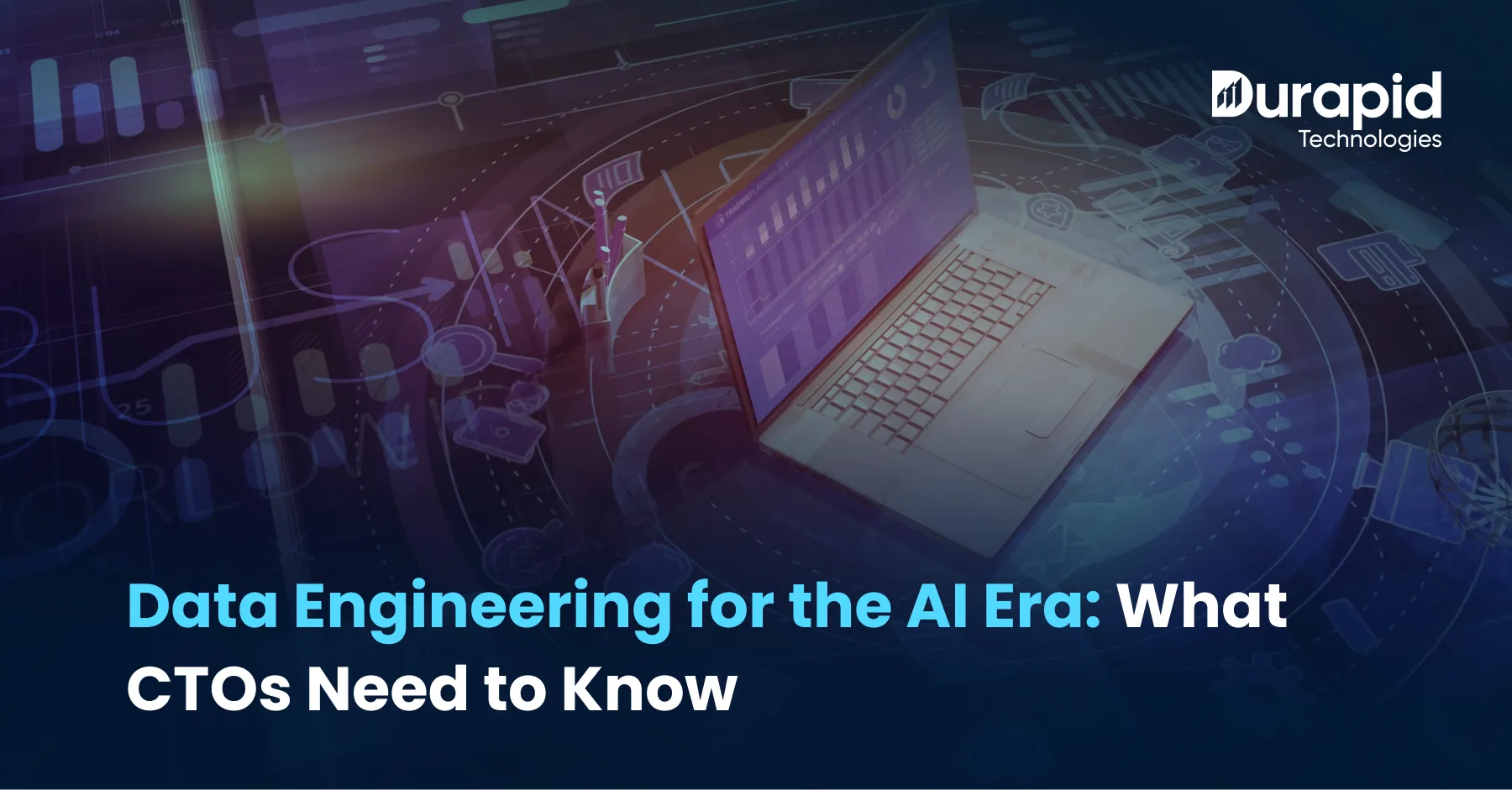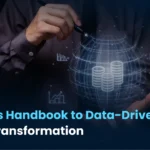Data Engineering for the AI Era: What CTOs Need to Know

Your AI models are only as good as the data feeding them.
And if we’re being honest, most organizations are feeding their AI projects junk data and wondering why they’re not seeing the breakthrough results they expected.
At Durapid Technologies, we’ve built 120+ web applications and worked with 35+ startups. Here’s what we’ve learned: the difference between AI projects that transform businesses and those that become expensive experiments comes down to one thing – data engineering.
Not the flashy machine learning algorithms. Not the fancy AI interfaces. The unglamorous, behind-the-scenes work of getting data ready for AI to actually work.
Your CTO probably doesn’t want to hear this, but your data infrastructure is likely the bottleneck holding back every AI initiative in your organization.
Read more about the critical relationship between AI and data engineering on our blog →
Building Scalable Data Pipelines for AI
Traditional data pipelines were built for reporting and analytics. You could get away with batch processing, some data quality issues, and manual interventions here and there.
AI doesn’t forgive those shortcuts.
When your AI model needs to make real-time decisions, whether it’s fraud detection, personalized recommendations, or predictive maintenance, it needs clean, consistent, and current data. Every single time.
Read how AI is evolving the data engineering landscape with practical tips on our insights page.
Here’s what we’ve learned building data pipelines for our clients across financial services, healthcare, and manufacturing:
Real-Time Processing Isn’t Optional Anymore
Your AI models need to learn and adapt continuously. Batch processing that updates once a day doesn’t cut it when market conditions change by the hour.
We implemented a real-time data pipeline for a financial services client using Azure Event Hubs and Databricks. The system processes over 10 million transactions per day, updates risk models continuously, and flags suspicious patterns within seconds. The old batch system would have caught those patterns three days too late.
Discover Azure’s data engineering best practices for real-time AI workloads in the official Microsoft documentation.
Data Quality at Scale
AI amplifies everything, including your data quality problems. A small inconsistency in your training data becomes a systematic bias in your model’s decisions.
Our approach uses automated data validation at every stage. We implement schema validation, anomaly detection, and data lineage tracking using Azure Data Factory and custom monitoring solutions. When something goes wrong, we know exactly where and can fix it before it impacts model performance.
See how our teams focus on quality in every step in our guide to choosing a data engineering partner.
Multi-Source Integration That Actually Works
Your AI models need data from everywhere, customer interactions, operational systems, external APIs, IoT devices. Traditional ETL processes weren’t designed for this complexity.
We’ve developed frameworks that handle streaming data from Kafka topics, batch data from legacy systems, and API data from cloud services, all feeding into unified data lakes on Azure Synapse. The key is building pipelines that can adapt to different data formats, velocities, and volumes without breaking.
Explore certified partner solutions for Azure Synapse in the official Microsoft partners directory.
The Role of Data Engineering in Model Success
Machine learning engineers get the glory. Data engineers make it possible.
After placing 300+ skilled developers and working with 95+ Databricks-certified professionals, we’ve seen this pattern repeatedly: the most successful AI projects spend 70% of their effort on data engineering and 30% on model development.
Discover how data engineering directly drives business transformation in our feature article: Unlocking Business Growth: The Power of Data Engineering.

Feature Engineering at Enterprise Scale
Your models are only as smart as the features you give them. Creating meaningful features from raw data, that’s where data engineering becomes AI engineering.
We built a churn prediction system for a retail client that processes customer interaction data, purchase history, and behavioral patterns to create over 200+ features in real-time. The model isn’t just predicting churn, it’s understanding the nuanced patterns that lead to customer dissatisfaction.
Model Training Infrastructure
Training AI models on enterprise data requires serious computational power and data management. You can’t just spin up a Jupyter notebook and call it production-ready.
Our teams have implemented distributed training pipelines using Databricks clusters that automatically scale based on data volume and model complexity. We handle data versioning, experiment tracking, and model reproducibility so your data science teams can focus on innovation instead of infrastructure.
Find a trusted Microsoft-certified services provider for these capabilities in the 2025 India top Microsoft partners list.
Continuous Learning Systems
Static models become obsolete models. Your data engineering needs to support continuous model retraining as new data arrives.
We’ve deployed systems that monitor model performance, detect drift, trigger retraining workflows, and seamlessly deploy updated models, all without human intervention. When market conditions change, your models adapt automatically.
Read about essential model ops and end-to-end integration in our Data Engineering vs Data Science comparison.
RAG-native and AI-ready Platforms
Retrieval-Augmented Generation isn’t just another AI buzzword, it’s fundamentally changing how we think about data architecture.
Traditional databases store information. RAG-native platforms make information available for AI reasoning.
What Makes a Platform RAG-Native
A RAG-native data platform is designed from the ground up to support AI models that need to retrieve relevant information from large knowledge bases and use that information to generate responses or make decisions.
Think of it this way: instead of pre-training models on everything they might ever need to know, RAG systems combine smaller, focused models with dynamic information retrieval. The model retrieves relevant context in real-time and uses that context to generate accurate, current responses.
Vector Databases and Semantic Search
RAG systems need more than traditional SQL queries. They need semantic understanding of data relationships.
We implement vector databases using Azure Cosmos DB and custom embeddings that understand context, not just keywords. When a model needs information about “customer satisfaction issues in Q4,” it finds related concepts like “service complaints,” “return rates,” and “support ticket escalations”—even if those exact terms weren’t in the query.
Knowledge Graph Integration
The most powerful RAG systems don’t just retrieve documents—they understand relationships between concepts, entities, and data points.
Our knowledge graph implementations using Azure Synapse map relationships between customers, products, transactions, and external market data. When AI models need context, they get not just relevant information but understanding of how different data points connect and influence each other.
Skills CTOs Should Hire For
The talent shortage in AI-ready data engineering is real. But knowing exactly what skills to prioritize makes hiring much more strategic.

Cloud-Native Data Engineering
Your next data engineers need to think cloud-first. Traditional on-premise data engineering skills don’t translate directly to cloud-scale AI workloads.
Look for expertise in Azure Data Factory, AWS Glue, or Google Cloud Dataflow. But more importantly, look for engineers who understand distributed computing, auto-scaling, and cost optimization for cloud data workloads.
At Durapid, our 120+ certified cloud consultants have this expertise because they’ve built systems that process terabytes of data cost-effectively.
MLOps and DataOps Integration
Data engineering for AI isn’t separate from machine learning operations, it’s integrated with MLOps from the start.
You need engineers who understand model deployment pipelines, A/B testing frameworks, and feature stores. They should be comfortable with tools like MLflow, Kubeflow, and Azure ML alongside traditional data engineering technologies.
Real-Time Stream Processing
Batch processing skills are table stakes. AI-ready data engineers need expertise in stream processing frameworks like Apache Kafka, Azure Event Hubs, and real-time analytics.
But technical skills aren’t enough. Look for engineers who understand the business implications of real-time data processing, why some decisions need millisecond latency while others can tolerate minutes or hours.
AI amplifies data governance challenges. Your data engineers need to understand GDPR, data lineage, and privacy-preserving techniques like differential privacy and federated learning.
This is especially critical for Indian enterprises dealing with international compliance requirements and increasing data localization mandates.
Case Studies
Financial Services: Real-Time Risk Assessment
A banking client came to us with a challenge: their existing risk assessment system took hours to process loan applications, and they were losing customers to fintech competitors offering instant decisions.
We rebuilt their data pipeline using Azure Synapse and Databricks, integrating data from credit bureaus, transaction histories, and alternative data sources. The new system processes applications in under 30 seconds with 40% better accuracy than their previous model.
The key wasn’t just faster processing, it was creating a data architecture that could incorporate new data sources and update risk models without rebuilding the entire system.
Healthcare: NLP for Medical Records
A healthcare provider wanted to use AI for clinical decision support but struggled with unstructured medical notes and inconsistent data formats.
We implemented an NLP pipeline using Azure Cognitive Services and custom models that process clinical notes, extract relevant medical concepts, and maintain HIPAA compliance throughout the data pipeline.
The system now helps clinicians identify potential drug interactions, suggests differential diagnoses, and flags patients at risk for readmission, all while maintaining complete audit trails for regulatory compliance.
Manufacturing: Predictive Maintenance at Scale
An industrial client needed to predict equipment failures across 50+ manufacturing facilities with different sensor types, maintenance schedules, and operational patterns.
We built a unified data platform that ingests IoT sensor data, maintenance logs, and production schedules into Azure Data Lake. Machine learning models trained on this data now predict failures 2-3 weeks in advance with 85% accuracy.
The platform scales automatically based on data volume and can incorporate new facilities or equipment types without manual reconfiguration.
The Indian Enterprise Advantage
Indian enterprises have a unique opportunity in the AI era. While global competitors are often constrained by legacy systems and regulatory complexity, Indian companies can build AI-ready data platforms from the ground up.

Leveraging India’s Technical Talent
India produces world-class data engineers and AI specialists. At Durapid, our teams in Jaipur work with global clients precisely because of this technical expertise combined with cost advantages.
But talent alone isn’t enough. You need teams that understand both cutting-edge AI technologies and practical business constraints. Our 150+ Microsoft-certified professionals bridge this gap by combining deep technical skills with real-world implementation experience.
Building for Global Scale
Indian enterprises increasingly serve global markets. Your data architecture needs to handle diverse regulatory requirements, multiple time zones, and varying data privacy laws.
We design data platforms that can comply with GDPR for European customers, handle data localization for Indian operations, and scale to support rapid international expansion.
Cost-Effective Innovation
Building AI-ready data platforms doesn’t require Silicon Valley budgets. Indian enterprises can achieve world-class AI capabilities using cloud-native architectures and strategic technology choices.
Our clients typically achieve 60-70% cost savings compared to traditional on-premise implementations while gaining significantly better performance and scalability.
The Path Forward
Data engineering for AI isn’t just about technology, it’s about building the foundation for continuous innovation.
The organizations that succeed in the AI era will be those that treat data engineering as a core competitive advantage, not just a supporting function.
Your AI models will evolve. Your business requirements will change. Market conditions will shift. But if you build your data platform right, it becomes the stable foundation that enables rapid adaptation and continuous improvement.
At Durapid Technologies, we’ve seen this transformation across industries and geographies. The companies that invest in AI-ready data engineering early gain advantages that compound over time.
Your competitors are working on their AI strategies. The question is whether they’re building the data foundation that makes those strategies actually work.
The AI era demands more from data engineering. But for organizations willing to make the investment, the rewards are transformational.
Frequently Asked Questions
How does data engineering drive AI success?
Data engineering creates the foundation that makes AI models accurate, reliable, and scalable. Without proper data pipelines, feature engineering, and real-time processing capabilities, even the most sophisticated AI algorithms fail in production. Quality data engineering ensures models have access to clean, relevant, and timely information, which directly translates to better predictions and business outcomes.
What is a RAG-native data platform?
A RAG-native data platform is designed specifically to support Retrieval-Augmented Generation AI systems. Unlike traditional databases that just store information, RAG-native platforms organize data for semantic search, maintain vector embeddings for similarity matching, and enable AI models to dynamically retrieve relevant context for generating responses. This architecture allows AI systems to access current information without requiring complete retraining.
How do modern data platforms benefit Indian enterprises?
Modern data platforms give Indian enterprises cost-effective access to world-class AI capabilities while supporting global scale and compliance requirements. They enable rapid innovation without massive infrastructure investments, provide built-in scalability for growth, and offer competitive advantages in serving both domestic and international markets. For Indian companies, this represents an opportunity to leapfrog traditional technology constraints and compete directly with global leaders.
Ready to build AI-ready data infrastructure for your enterprise? Durapid Technologies combines deep technical expertise with practical implementation experience. Our team of 95+ Databricks-certified professionals and 120+ cloud consultants can help design and implement data platforms that scale with your AI ambitions. Contact us at sales@durapid.com or visit www.durapid.com to discuss your data engineering strategy.





